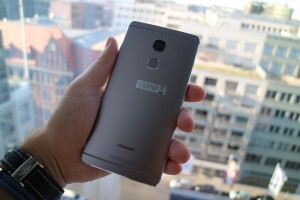The China-based smartphone maker Huawei may only flirt with the US market, but its no also-ran, as evident by its most advanced device to date, which it debuted at IFA in Berlin: the Huawei Mate S. This is a essentially a smaller, 5.5-inch take on the Ascend Mate 7 phablet Huawei debuted one year ago at IFA; however it features several interesting innovations.
The feature that had IFA attendees buzzing the most is something Huawei calls Force Touch technology, which turns the standard 2D, full HD display into something Huawei dubs a 2.5D display. Force Touch is pressure sensitive touchscreen technology already present in theApple Watch, which expected in the upcoming iPhone 6S. In regards to smartphones, Huawei seems to have beaten Apple to it.
That said, Force Touch doesn’t seem to bring much to the device when it’s held in hand, at least in our limited hands-on time. The application of this technology, which seemingly has future functional potential, is simply not evident at the IFA debut.
Perhaps the coolest Force Touch feature Huawei demonstrated is the zoom level; the harder you press with your finger, the more the camera zooms. In addition, when positioned on a table, the handset’s display can be used as a scale for smaller objects, which we tested out and found it works with the expected precision. Outside of that, what else can one do with a Force Touch display?
Huawei also placed a lot of emphasis on the improved Knuckle Control technology, which enables the display to recognize the difference between fingertip taps and presses, and finger knuckle drags. For example, “writing” certain letters opens certain apps, like “W” for weather or “C” for camera.
Compared to Ascend Mate 7, Mate S comes with slightly greater pixel density of 401 pixels per inch (same resolution, smaller display), Gorilla Glass 4, and AMOLED technology, making the display is one of its main selling points. The colors look exceptionally convincing, with a sharp edge, and typical AMOLED saturation and brightness. The contrast is highly sustainable, and it enables a large viewing angle with solid black tones, but also slightly dirty whites.
The device features a 13-megapixel BSI back-facing camera with optical image stabilization
The device features a 13-megapixel BSI back-facing camera with optical image stabilization, which corrects movements up to 1.2 degrees, as well as a f/2.0 lens. 2015 has already seen a lot of great smartphone cameras, and Huawei is still keeping up with the competition. This camera seems to have the best among Huawei’s phones, but seems to lag behind the best in the flagship category when it comes to detail level, exposure precision, noise, and image sharpness. Mate S’s selfie camera sports 8-megapixels and has an f/2.4 lens. That’s a good resolution, though we worry how it might perform in low light.
The device features a chipset based on two quad-core sets, including the manufacturer’s in-house platform called Kirin 935. It also has Mali-T628 graphic processor, 3GB of RAM and 32 or 64GB of memory storage, which can be expanded with microSD cards. The battery has a luxurious capacity of 2700 mAh. In our hands-on time, it performed well and fluidly.
It should be pointed out that Huawei Mate S has an exceptional metal finish, and it feels premium in hand. It’s fingerprint scanner is now faster than it was on the previous version.
Overall, the Mate S is a high-end device, and it seems that the price will follow suit, which is unusual for Huawei. The 32GB Huawei Mate S will cost 649 euros (about $730 US) and the 64GB version will cost 699 euros (about $777 US). It will be available in the second half of September throughout the globe.

